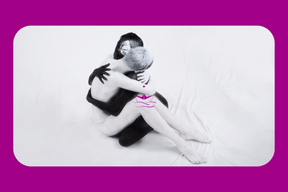Yin Yang of the Love
"The Yin and Yang of Love" by Shan-tung Hsu is the first book I recommend when I’m asked about the nature of feminine and masculine energies. Its narrative is simple and clear. Meaning sometimes gets lost in the intricacies of words, but that’s not the case in this book. It explains the concepts of yin and yang in a straightforward way, particularly through relationships.
As I often say, we Western minds (or rather, we who are a mix of Eastern and Western minds) struggle to fully grasp the concept of yin and yang, because we perceive concepts through definite, clear lines, not from an Eastern perspective. Shan-tung Hsu simplifies this message for us.
In the book, he says, “What manifests as sexual desire, romance, and love is actually the soul’s longing to return to its original unity, to once again become a complete Tai Chi, a full and balanced being.” We encounter these ideas in psychology too—the perpetual desire to return to oneness with the mother, or from a more spiritual perspective, to return to oneness with the universe, with the self. It’s the longing to reunite with the source.
He explains the distinction between yin and yang energy as follows: “One is more closely related to the unseen or invisible aspects of things, while the other is related to the visible aspects.” “While a man measures with tons, a woman uses grams.” Here, I must emphasize that nothing can be purely yin or purely yang. So, why do we need polarity?
“If there is no distinction or difference, there is no polarity, and without polarity, there is no flow of energy.”
Because, after all, that which is not polarized is one, singular. It has no need to flow or move in any other direction. Every concept we speak of on the earthly plane is subject to its duality, its yin and yang.
In later chapters, he touches on Feng Shui, which is not within my area of interest, so I’ll skip that part. Afterward, there’s a section on Body, Mind, and Chi. “Most traditional exercises in Asia focus on strengthening the internal organs and balancing energy, rather than focusing on the outer muscles,” he says. This applies to dance as well, because when we focus on the transitions between movements, rather than the movements themselves, it activates the deeper layers of the body. Transitions are the core of the dance.
He adds, “There are various types of dance, all of which require a close relationship between rhythm and pattern; these two things help integrate physical and mental energies.” Indeed, dance is a powerful tool for grasping the unity of body, mind, and emotion. Physical activities based solely on movement, like sports, are of course beneficial to us, but movement done without listening to the body loses its emotional depth. Without emotional healing, one cannot become whole with oneself. You’re merely moving. The body, however, is not just a collection of blood, veins, lymph, bones, and muscles. The body is a treasure chest of hidden senses and emotions.
The book also refers to a Zen saying: “The body is a wisdom tree, and the mind is a mirror.”
To reach the wisdom of the body, we don’t actually need to strive too hard. On the contrary, when we let go of effort in movement and pay more attention to our inner connections, our wisdom is activated.
This wisdom is simple—knowing what will truly serve you, being able to sleep when you're tired, cry when you're sad, take action for what you want, meet with whom you desire, and avoid those you don’t. The mind doesn’t actually know these things. The mind is only concerned with ideals and what “should be.” Life is guided by another force—the simple wisdom of life itself.
To make being human easier, we need to remember the body and broaden our definition of it.
The body is yang, and all those unseen mysteries within the body are yin. Do you have the courage to taste your body, with all of its hidden mysteries?"**


